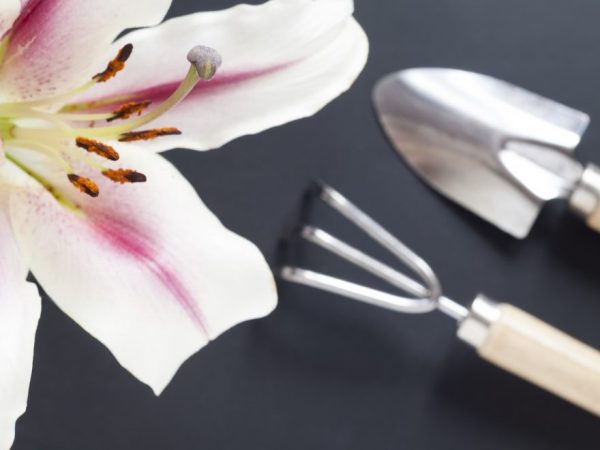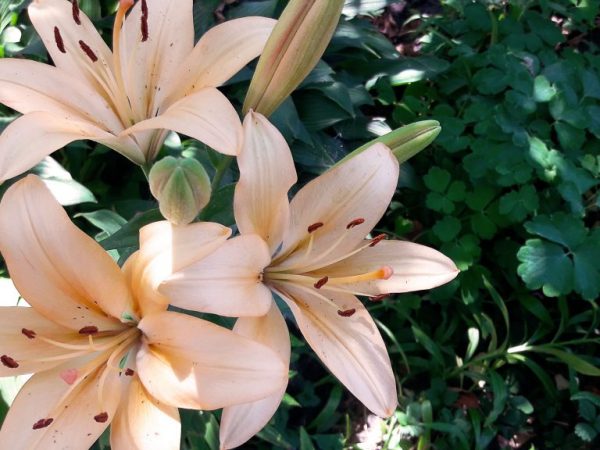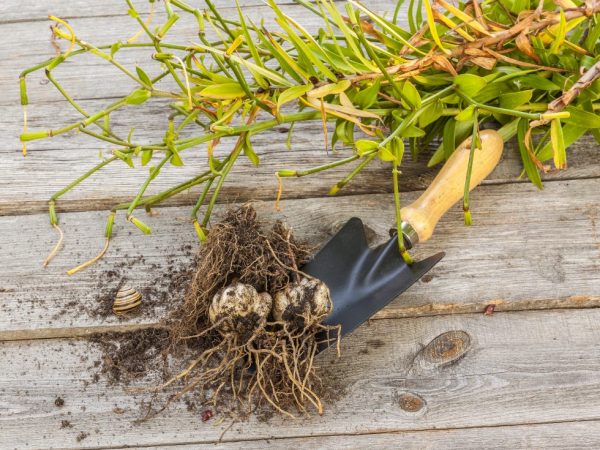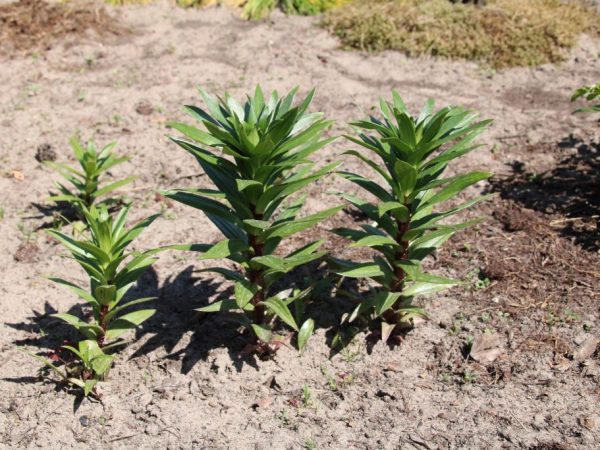Lily transplant - is it possible in the autumn
Lilies are incredibly attractive flowers that can decorate any garden with their grace. However, due to their high decorative qualities, they have a rather capricious character. Their autumn transplantation to another place requires a serious approach and responsibility. If certain norms are not observed, the plant may get sick or not take root at all.

Lily transplant - is it possible in the autumn
Why transplant
Lilies are perennial plants and can feel quite comfortable during the winter in the open field due to the shape of the root system in the form of bulbs.
However, after several seasons of staying in a permanent place, their growth is noticeably inhibited, flowering becomes scarce.
The impetus for the activation and acceleration of internal processes is transplantation to another place. It should be chosen taking into account the fact that there should have been no other crops in this area during the previous 12 months.
The ideal solution is an untouched, rested substrate, when placed in which the flower can be saturated with useful microelements in sufficient volume and bloom with renewed vigor.
In the case of regular neglect of this procedure, the plants' immunity decreases, they get sick 3-4 times more often.
Benefits of the autumn procedure
Many gardeners often wonder when is the best time to transplant - in the spring or autumn. Both seasons are favorable.
There are a number of clear advantages in favor of the events held in the fall:
- a high degree of “acceptance” in a new place due to the forces accumulated during the flowering period;
- no need to store seed throughout the winter in the house, it is immediately transported to another site;
- convenience in reproduction, after the growing season, "babies" are formed near the mother bulb.
However, there are situations when it is impossible to transfer a plant:
- early onset of cold weather;
- cultivation of late varieties that still continue to bloom in the fall;
- harsh climatic conditions requiring bulbs to be dug up.
Suitable dates
One of the basic rules for transplanting is the flowering period. Upon completion, it is necessary to withstand 1.5-2 months.
With a later digging, the likelihood that the plant will have time to prepare for the onset of cold weather and will give beautiful flowers next season is minimized.
Lunar calendar
The moon is capable of influencing all living organisms and plants as well.
Based on this material, there are several favorable periods for transplanting bulbous in the fall of 2019:
- in September - from 10 to 24;
- in October - from 10 to 23;
- in November - from 8 to 22.
By region

Flower health depends on proper care
An important factor is the climatic conditions, which differ relative to the growing regions.
The ideal air temperature during the event is at least 12 °. Do not expect good results when planting bulbs in cold soil.
Terms depending on the territorial location:
- Moscow region, Leningrad region - August / September;
- Siberia - August, September (subject to warm weather);
- Ural - from early September to early October;
- The middle strip of Russia is mid-September-mid-October (it is recommended to rely on the weather forecast);
- Subpolar and polar zones - digging of the bulbs is required, if necessary, transplant activities are carried out no later than August.
Transplant rules
If a mistake was made during planting, there is a chance that the plant will take root. However, it is unlikely that next year you will be able to contemplate a gorgeous flowerbed with these flowers.
The process requires sufficient responsibility from the gardener.
What varieties to plant
It is recommended to transplant lilies to a new place at a certain frequency, which is directly related to their variety.
- Martagon and American hybrids feel quite comfortable without a change of scenery for 8-10 years.
- Tubular and Asian need to be moved every 2 years, some of them annually;
- All other species can live for 4-5 years without the need to “move”.
Choosing a landing site
When choosing a territory for transplanting a daylily, several aspects must be taken into account:
- Illumination. Requirements for it vary depending on the variety, so it is very important to clarify this information in advance. Basically, it is customary to believe that all lilies prefer to grow in well-lit areas, but in the case of Martagon, partial shade would be the ideal solution. The bright sun is destructive for this species. La hybrids and Asian varieties, on the other hand, suffer under similar conditions.
- Windiness. Aristocratic lilies do not tolerate drafts at all, which is due to the not particularly resistant stem of the plant. With regular exposure to gusts of wind, the decorative qualities of the flower are noticeably reduced. But overdoing it in protecting the bush is also fraught, it does not tolerate air stagnation, and if supplemented with high humidity, it loses its immunity to pests and diseases. It is better if it is a flat, or with a slight slope. When located along the fence, it is preferable to choose the east or south side.
Land preparation
Lilies have high demands on the structure and chemical composition of the soil. It should be prepared 3-4 weeks before the planned agrotechnical work.
Ideally, the soil should be loose, well-drained, due to the fact that the stagnation of liquid during the thaw period has an extremely unfavorable effect on the condition and health of the plant.
If the site is characterized by constant high humidity, special grooves are built on it to drain melt water, the bottom of which is sprinkled with a layer of river sand or gravel 4-7 cm thick.
The acidity of the soil will also have to be adjusted. Asian, American and Oriental varieties prefer a more acidic substrate, which can be achieved by applying peat. Chalk and wood ash give an alkaline reaction.
The earth is pre-dug about on the bayonet of a shovel, carefully choosing the roots of the weed. With a high clay content (permissible rate of 20%), supplement with sand, turf and humus.
Plant preparation

Bulbs need to be processed
The seed is processed before planting.
Use foundationol or karbofos in a ratio of 2 g per 1 liter. A commercially available preparation “Maxim” or a saturated solution of potassium permanganate is also suitable.
The bulbs are soaked for half an hour, then dried in partial shade. Additionally, it is recommended to remove dead and dry husks from the surface.
Digging should be extremely careful due to the fact that for the entire time it was in the old place, the underground part of the lily could grow quite strongly.
If necessary, the reproduction of children is separated. If they are absent, it is allowed to divide the bulb itself into several segments according to the type of head of garlic.
Transplant technology
It is necessary to transplant the lily into a hole, the size of which is commensurate with the dimensions of the bulb itself.
It should be deepened taking into account the height of the plant:
- undersized ones are immersed to a depth of 15-20 cm, the distance between the planting pits is kept 30-40 cm;
- medium-sized ones are placed in a substrate of 12-15 cm, provided that there is a gap between the bushes of 25-30 cm;
- low ones are buried at 7-10 cm, the step between flowers is 15-18 cm.
Chronology of the process:
- A little fine sand is poured into a hole dug out according to all the rules.
- Place the onion so that only the roots are in the sand.
- Cover the hole with earth.
- A layer of sawdust or peat is distributed on top, acting as an additional fertilizer at the onset of spring.
Follow-up care
Caring for lilies transplanted in the fall is not particularly difficult. Particularly dry soil is watered abundantly, after which it is carefully loosened and mulched.
In the event of a severe winter forecast, the surface of the earth is additionally covered when the temperature drops to 0 or -4 °.
The list of fertilizers for autumn feeding is standard:
- potassium sulfate (50 g per 1 sq.m.);
- rotted plant compost 8-10 kg (it is allowed to replace it with 5 kg of cow dung);
- superphosphate (80 g per 1 sq.m.).
When shoots appear

Weather conditions affect plant growth
The first shoots of lilies planted in autumn fall in the spring.
The month depends on the type of flower:
- tubular are activated in growth in March-April;
- Asian - in May.
Also, the growing season can fluctuate depending on weather conditions. Flowering generally begins in mid-June and lasts until the first days of August.
Such early varieties as Alyonushka or Mona Lisa release a peduncle in May. The late ones can be admired in August-September.
Do I need to dig up lilies for the winter
Not all lilies can endure winter frosts without loss, especially for tubular varieties, which even a carefully equipped shelter cannot save from low temperatures.
Therefore, they need to be dug out at a certain time:
- OT hybrids - in the last days of August;
- oriental varieties - in September;
- LA hybrids and Asian hybrids in mid-August.
After removing the material from the ground, it is carefully examined, damaged and dry elements are removed, and washed in running water. In the future, it is kept for 20 minutes in a weakly saturated solution of potassium permanganate and dried.
A wooden box or a dense bag is used as a container, filled with peat. Keeping the bulbs at room temperature is unacceptable, the best option is from 0 to 5 °.
It is preferable to choose a place that is darkened (otherwise premature plant growth will begin) with moderate humidity, increased indicators provoke the occurrence of mold and fungal diseases.
The best way to store daylilies is to place the seed in special heat chambers and put them on the loggia, if we are talking about apartments, or in the basement.
During the entire hibernation period, it is recommended to systematically check the condition of the bulbs. In case of excessive dryness, spray with water from a spray bottle, in case of decay, treat with potassium permanganate.
Summing up
When exactly to transplant a beautiful lily, in spring or autumn, is a question, the decision of which is entirely up to the gardener.
In any case, the plant needs care. Providing it at the proper level, admiring the gorgeous garden will be real for a long time.

